Organizational Context and Design in Al Mulla Group
VerifiedAdded on 2023/06/07
|11
|2816
|51
AI Summary
This article discusses the organizational context and design of Al Mulla Group, including external factors analysis, historical and theoretical perspective, organizational design models, and the link between organizational design and people management.
Contribute Materials
Your contribution can guide someone’s learning journey. Share your
documents today.
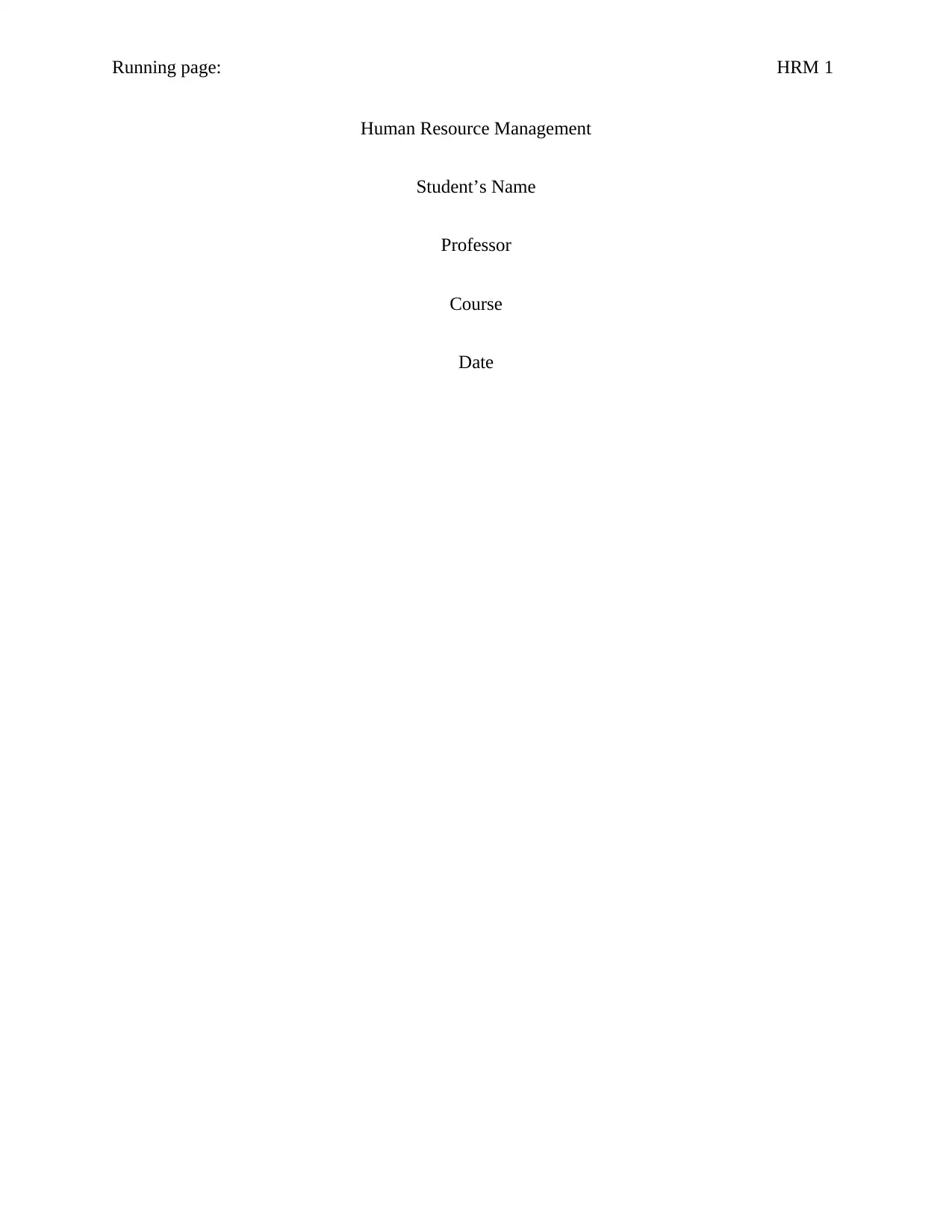
Running page: HRM 1
Human Resource Management
Student’s Name
Professor
Course
Date
Human Resource Management
Student’s Name
Professor
Course
Date
Secure Best Marks with AI Grader
Need help grading? Try our AI Grader for instant feedback on your assignments.
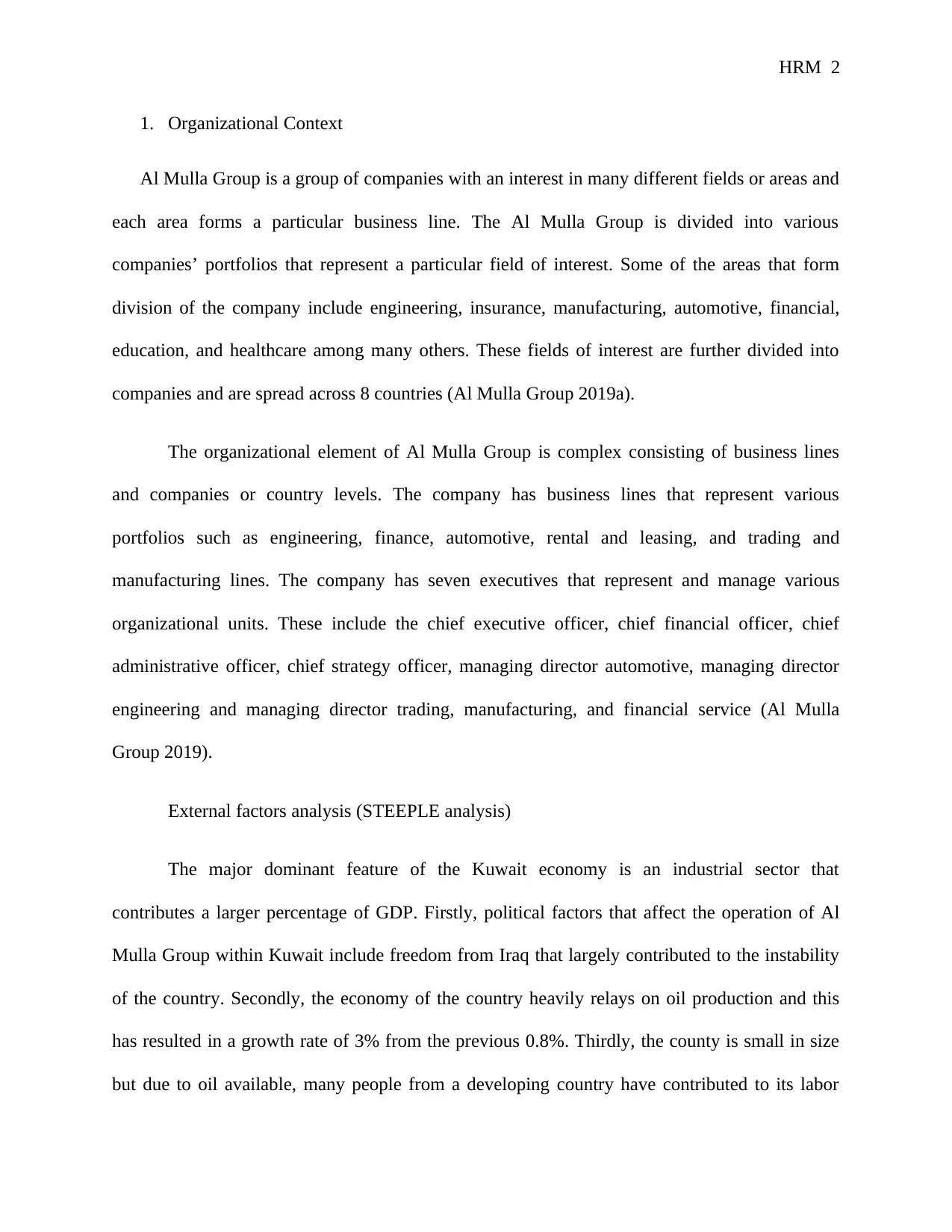
HRM 2
1. Organizational Context
Al Mulla Group is a group of companies with an interest in many different fields or areas and
each area forms a particular business line. The Al Mulla Group is divided into various
companies’ portfolios that represent a particular field of interest. Some of the areas that form
division of the company include engineering, insurance, manufacturing, automotive, financial,
education, and healthcare among many others. These fields of interest are further divided into
companies and are spread across 8 countries (Al Mulla Group 2019a).
The organizational element of Al Mulla Group is complex consisting of business lines
and companies or country levels. The company has business lines that represent various
portfolios such as engineering, finance, automotive, rental and leasing, and trading and
manufacturing lines. The company has seven executives that represent and manage various
organizational units. These include the chief executive officer, chief financial officer, chief
administrative officer, chief strategy officer, managing director automotive, managing director
engineering and managing director trading, manufacturing, and financial service (Al Mulla
Group 2019).
External factors analysis (STEEPLE analysis)
The major dominant feature of the Kuwait economy is an industrial sector that
contributes a larger percentage of GDP. Firstly, political factors that affect the operation of Al
Mulla Group within Kuwait include freedom from Iraq that largely contributed to the instability
of the country. Secondly, the economy of the country heavily relays on oil production and this
has resulted in a growth rate of 3% from the previous 0.8%. Thirdly, the county is small in size
but due to oil available, many people from a developing country have contributed to its labor
1. Organizational Context
Al Mulla Group is a group of companies with an interest in many different fields or areas and
each area forms a particular business line. The Al Mulla Group is divided into various
companies’ portfolios that represent a particular field of interest. Some of the areas that form
division of the company include engineering, insurance, manufacturing, automotive, financial,
education, and healthcare among many others. These fields of interest are further divided into
companies and are spread across 8 countries (Al Mulla Group 2019a).
The organizational element of Al Mulla Group is complex consisting of business lines
and companies or country levels. The company has business lines that represent various
portfolios such as engineering, finance, automotive, rental and leasing, and trading and
manufacturing lines. The company has seven executives that represent and manage various
organizational units. These include the chief executive officer, chief financial officer, chief
administrative officer, chief strategy officer, managing director automotive, managing director
engineering and managing director trading, manufacturing, and financial service (Al Mulla
Group 2019).
External factors analysis (STEEPLE analysis)
The major dominant feature of the Kuwait economy is an industrial sector that
contributes a larger percentage of GDP. Firstly, political factors that affect the operation of Al
Mulla Group within Kuwait include freedom from Iraq that largely contributed to the instability
of the country. Secondly, the economy of the country heavily relays on oil production and this
has resulted in a growth rate of 3% from the previous 0.8%. Thirdly, the county is small in size
but due to oil available, many people from a developing country have contributed to its labor
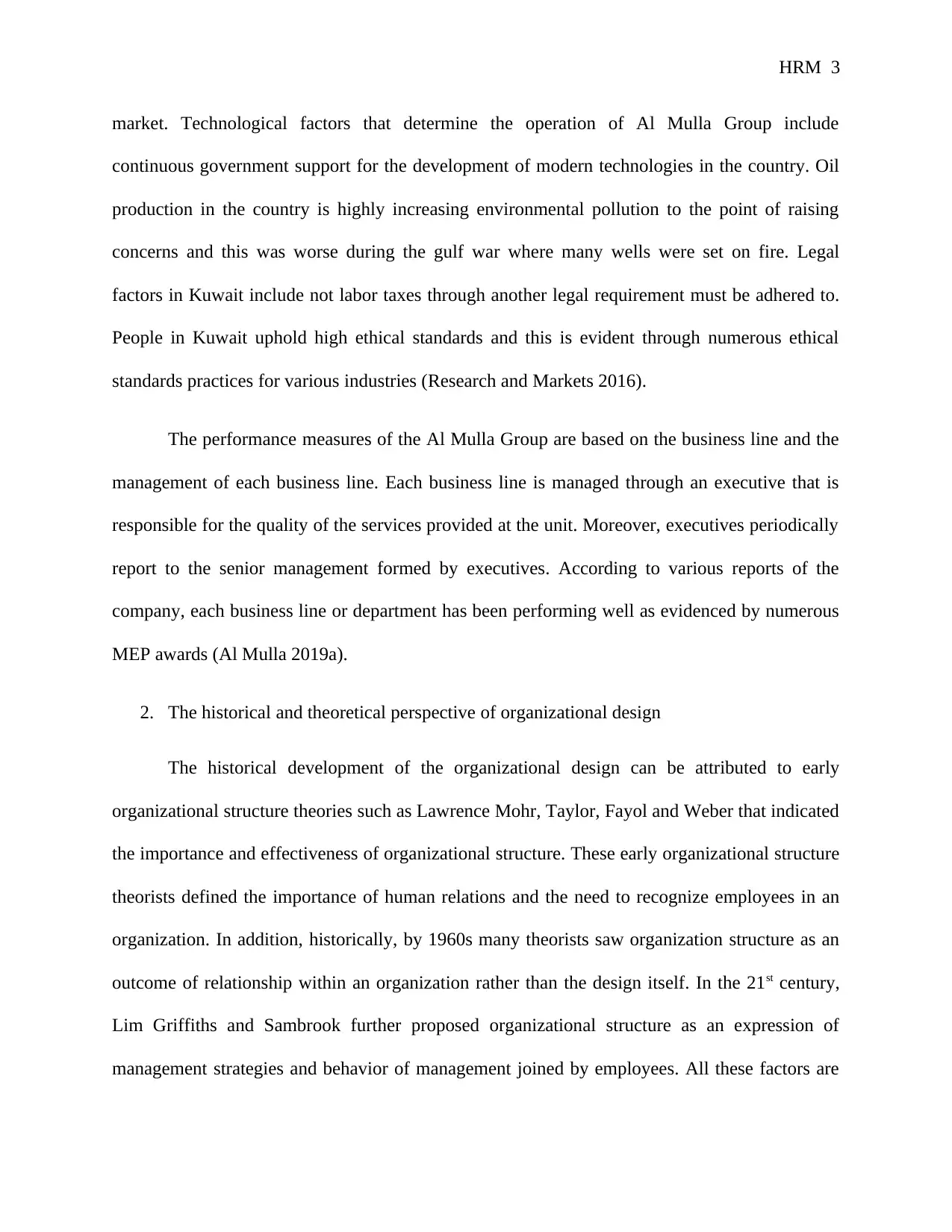
HRM 3
market. Technological factors that determine the operation of Al Mulla Group include
continuous government support for the development of modern technologies in the country. Oil
production in the country is highly increasing environmental pollution to the point of raising
concerns and this was worse during the gulf war where many wells were set on fire. Legal
factors in Kuwait include not labor taxes through another legal requirement must be adhered to.
People in Kuwait uphold high ethical standards and this is evident through numerous ethical
standards practices for various industries (Research and Markets 2016).
The performance measures of the Al Mulla Group are based on the business line and the
management of each business line. Each business line is managed through an executive that is
responsible for the quality of the services provided at the unit. Moreover, executives periodically
report to the senior management formed by executives. According to various reports of the
company, each business line or department has been performing well as evidenced by numerous
MEP awards (Al Mulla 2019a).
2. The historical and theoretical perspective of organizational design
The historical development of the organizational design can be attributed to early
organizational structure theories such as Lawrence Mohr, Taylor, Fayol and Weber that indicated
the importance and effectiveness of organizational structure. These early organizational structure
theorists defined the importance of human relations and the need to recognize employees in an
organization. In addition, historically, by 1960s many theorists saw organization structure as an
outcome of relationship within an organization rather than the design itself. In the 21st century,
Lim Griffiths and Sambrook further proposed organizational structure as an expression of
management strategies and behavior of management joined by employees. All these factors are
market. Technological factors that determine the operation of Al Mulla Group include
continuous government support for the development of modern technologies in the country. Oil
production in the country is highly increasing environmental pollution to the point of raising
concerns and this was worse during the gulf war where many wells were set on fire. Legal
factors in Kuwait include not labor taxes through another legal requirement must be adhered to.
People in Kuwait uphold high ethical standards and this is evident through numerous ethical
standards practices for various industries (Research and Markets 2016).
The performance measures of the Al Mulla Group are based on the business line and the
management of each business line. Each business line is managed through an executive that is
responsible for the quality of the services provided at the unit. Moreover, executives periodically
report to the senior management formed by executives. According to various reports of the
company, each business line or department has been performing well as evidenced by numerous
MEP awards (Al Mulla 2019a).
2. The historical and theoretical perspective of organizational design
The historical development of the organizational design can be attributed to early
organizational structure theories such as Lawrence Mohr, Taylor, Fayol and Weber that indicated
the importance and effectiveness of organizational structure. These early organizational structure
theorists defined the importance of human relations and the need to recognize employees in an
organization. In addition, historically, by 1960s many theorists saw organization structure as an
outcome of relationship within an organization rather than the design itself. In the 21st century,
Lim Griffiths and Sambrook further proposed organizational structure as an expression of
management strategies and behavior of management joined by employees. All these factors are
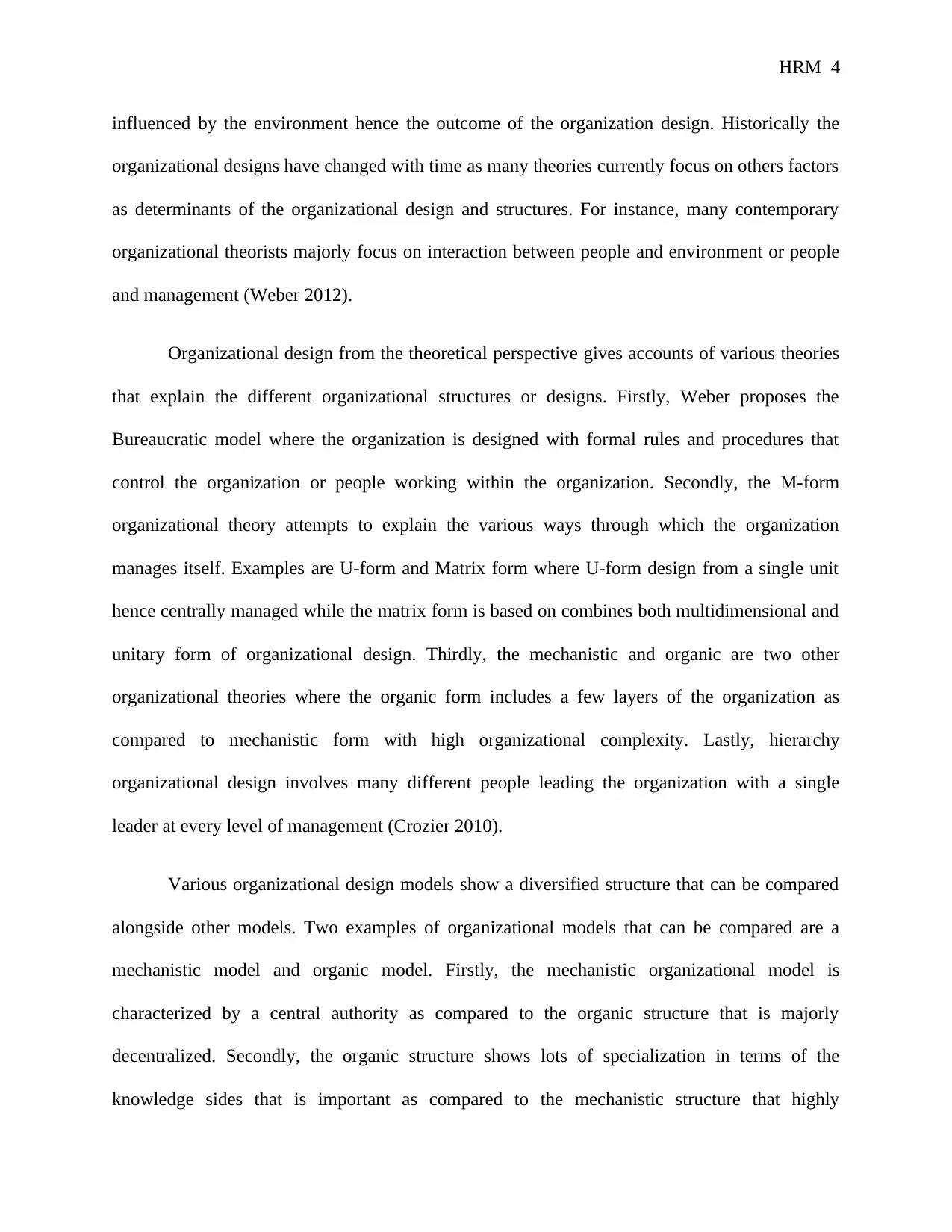
HRM 4
influenced by the environment hence the outcome of the organization design. Historically the
organizational designs have changed with time as many theories currently focus on others factors
as determinants of the organizational design and structures. For instance, many contemporary
organizational theorists majorly focus on interaction between people and environment or people
and management (Weber 2012).
Organizational design from the theoretical perspective gives accounts of various theories
that explain the different organizational structures or designs. Firstly, Weber proposes the
Bureaucratic model where the organization is designed with formal rules and procedures that
control the organization or people working within the organization. Secondly, the M-form
organizational theory attempts to explain the various ways through which the organization
manages itself. Examples are U-form and Matrix form where U-form design from a single unit
hence centrally managed while the matrix form is based on combines both multidimensional and
unitary form of organizational design. Thirdly, the mechanistic and organic are two other
organizational theories where the organic form includes a few layers of the organization as
compared to mechanistic form with high organizational complexity. Lastly, hierarchy
organizational design involves many different people leading the organization with a single
leader at every level of management (Crozier 2010).
Various organizational design models show a diversified structure that can be compared
alongside other models. Two examples of organizational models that can be compared are a
mechanistic model and organic model. Firstly, the mechanistic organizational model is
characterized by a central authority as compared to the organic structure that is majorly
decentralized. Secondly, the organic structure shows lots of specialization in terms of the
knowledge sides that is important as compared to the mechanistic structure that highly
influenced by the environment hence the outcome of the organization design. Historically the
organizational designs have changed with time as many theories currently focus on others factors
as determinants of the organizational design and structures. For instance, many contemporary
organizational theorists majorly focus on interaction between people and environment or people
and management (Weber 2012).
Organizational design from the theoretical perspective gives accounts of various theories
that explain the different organizational structures or designs. Firstly, Weber proposes the
Bureaucratic model where the organization is designed with formal rules and procedures that
control the organization or people working within the organization. Secondly, the M-form
organizational theory attempts to explain the various ways through which the organization
manages itself. Examples are U-form and Matrix form where U-form design from a single unit
hence centrally managed while the matrix form is based on combines both multidimensional and
unitary form of organizational design. Thirdly, the mechanistic and organic are two other
organizational theories where the organic form includes a few layers of the organization as
compared to mechanistic form with high organizational complexity. Lastly, hierarchy
organizational design involves many different people leading the organization with a single
leader at every level of management (Crozier 2010).
Various organizational design models show a diversified structure that can be compared
alongside other models. Two examples of organizational models that can be compared are a
mechanistic model and organic model. Firstly, the mechanistic organizational model is
characterized by a central authority as compared to the organic structure that is majorly
decentralized. Secondly, the organic structure shows lots of specialization in terms of the
knowledge sides that is important as compared to the mechanistic structure that highly
Paraphrase This Document
Need a fresh take? Get an instant paraphrase of this document with our AI Paraphraser
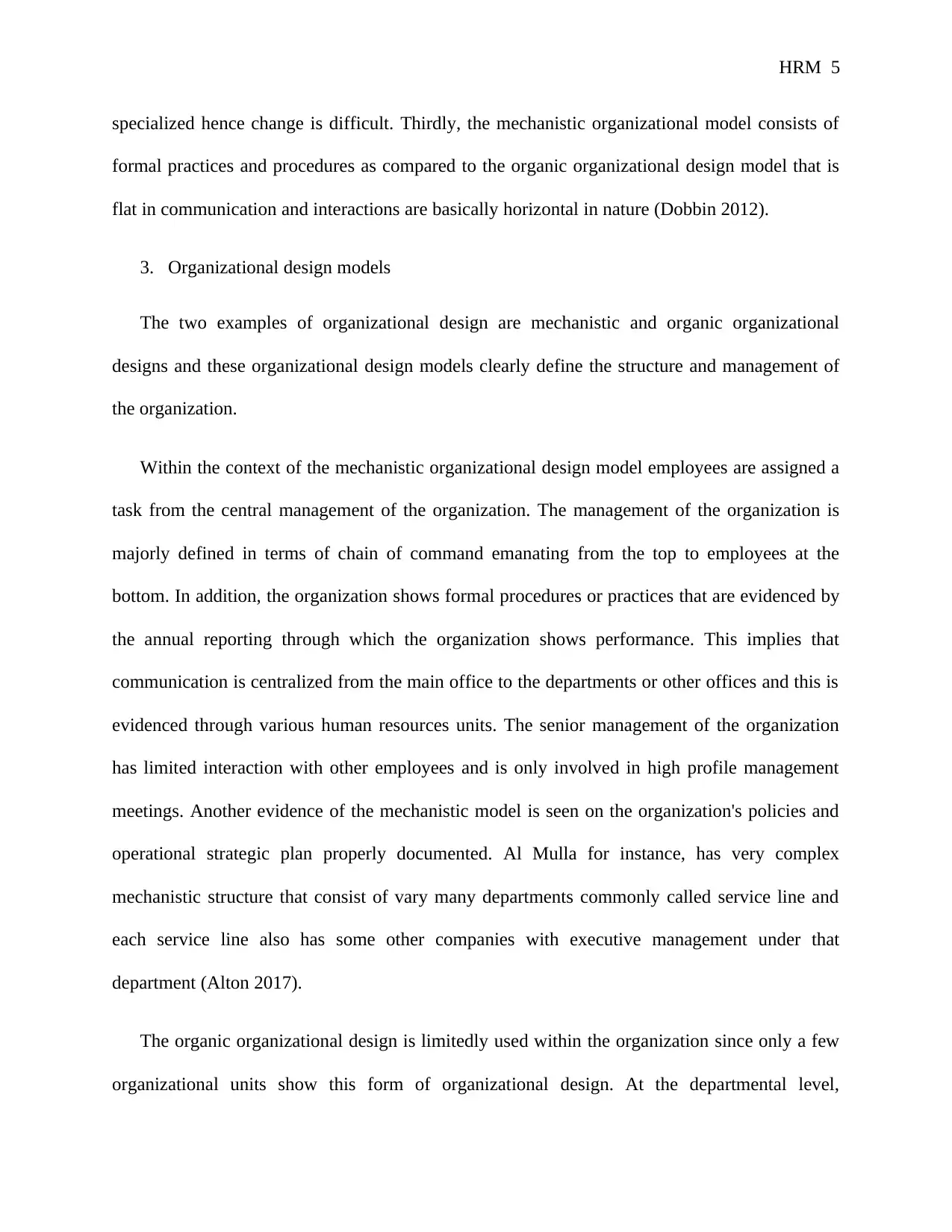
HRM 5
specialized hence change is difficult. Thirdly, the mechanistic organizational model consists of
formal practices and procedures as compared to the organic organizational design model that is
flat in communication and interactions are basically horizontal in nature (Dobbin 2012).
3. Organizational design models
The two examples of organizational design are mechanistic and organic organizational
designs and these organizational design models clearly define the structure and management of
the organization.
Within the context of the mechanistic organizational design model employees are assigned a
task from the central management of the organization. The management of the organization is
majorly defined in terms of chain of command emanating from the top to employees at the
bottom. In addition, the organization shows formal procedures or practices that are evidenced by
the annual reporting through which the organization shows performance. This implies that
communication is centralized from the main office to the departments or other offices and this is
evidenced through various human resources units. The senior management of the organization
has limited interaction with other employees and is only involved in high profile management
meetings. Another evidence of the mechanistic model is seen on the organization's policies and
operational strategic plan properly documented. Al Mulla for instance, has very complex
mechanistic structure that consist of vary many departments commonly called service line and
each service line also has some other companies with executive management under that
department (Alton 2017).
The organic organizational design is limitedly used within the organization since only a few
organizational units show this form of organizational design. At the departmental level,
specialized hence change is difficult. Thirdly, the mechanistic organizational model consists of
formal practices and procedures as compared to the organic organizational design model that is
flat in communication and interactions are basically horizontal in nature (Dobbin 2012).
3. Organizational design models
The two examples of organizational design are mechanistic and organic organizational
designs and these organizational design models clearly define the structure and management of
the organization.
Within the context of the mechanistic organizational design model employees are assigned a
task from the central management of the organization. The management of the organization is
majorly defined in terms of chain of command emanating from the top to employees at the
bottom. In addition, the organization shows formal procedures or practices that are evidenced by
the annual reporting through which the organization shows performance. This implies that
communication is centralized from the main office to the departments or other offices and this is
evidenced through various human resources units. The senior management of the organization
has limited interaction with other employees and is only involved in high profile management
meetings. Another evidence of the mechanistic model is seen on the organization's policies and
operational strategic plan properly documented. Al Mulla for instance, has very complex
mechanistic structure that consist of vary many departments commonly called service line and
each service line also has some other companies with executive management under that
department (Alton 2017).
The organic organizational design is limitedly used within the organization since only a few
organizational units show this form of organizational design. At the departmental level,
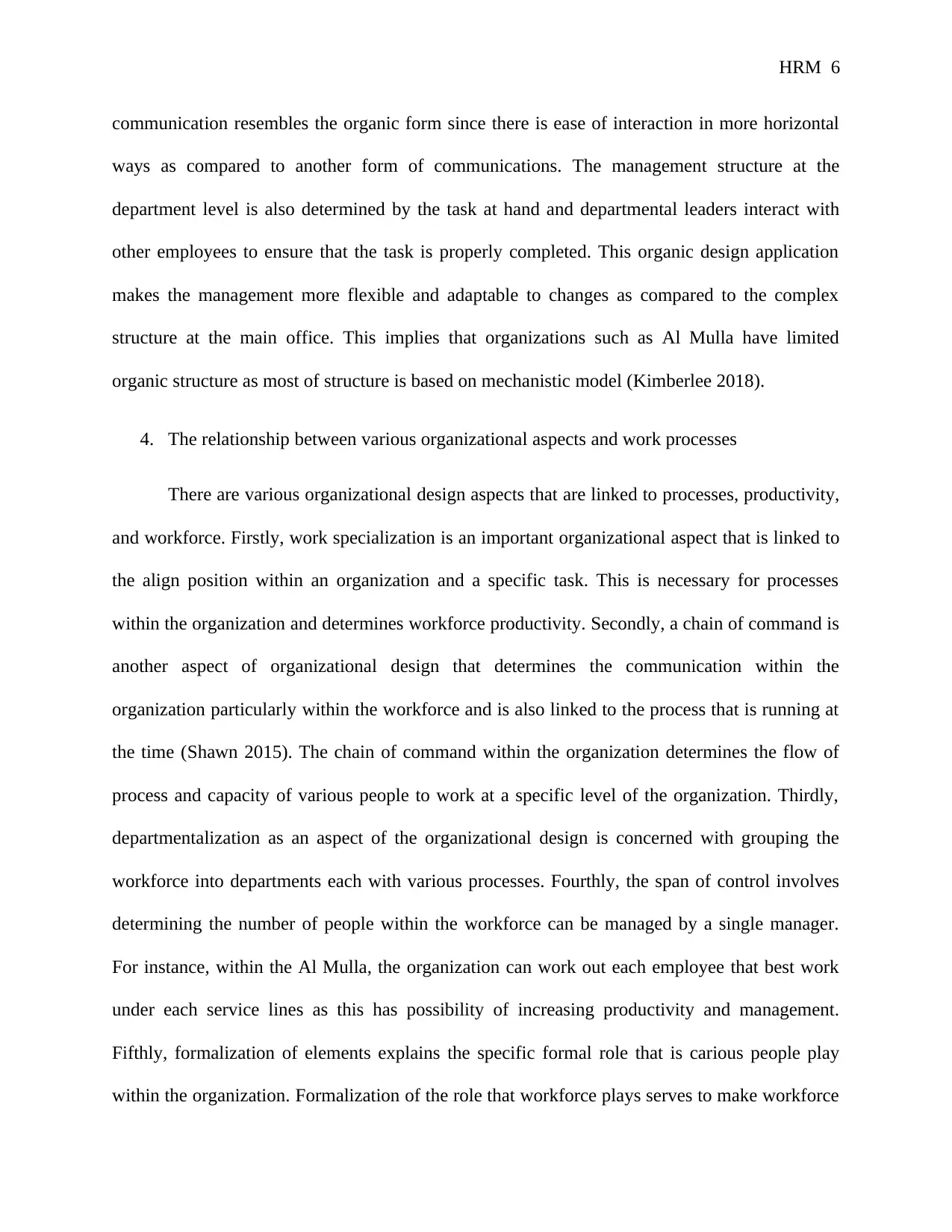
HRM 6
communication resembles the organic form since there is ease of interaction in more horizontal
ways as compared to another form of communications. The management structure at the
department level is also determined by the task at hand and departmental leaders interact with
other employees to ensure that the task is properly completed. This organic design application
makes the management more flexible and adaptable to changes as compared to the complex
structure at the main office. This implies that organizations such as Al Mulla have limited
organic structure as most of structure is based on mechanistic model (Kimberlee 2018).
4. The relationship between various organizational aspects and work processes
There are various organizational design aspects that are linked to processes, productivity,
and workforce. Firstly, work specialization is an important organizational aspect that is linked to
the align position within an organization and a specific task. This is necessary for processes
within the organization and determines workforce productivity. Secondly, a chain of command is
another aspect of organizational design that determines the communication within the
organization particularly within the workforce and is also linked to the process that is running at
the time (Shawn 2015). The chain of command within the organization determines the flow of
process and capacity of various people to work at a specific level of the organization. Thirdly,
departmentalization as an aspect of the organizational design is concerned with grouping the
workforce into departments each with various processes. Fourthly, the span of control involves
determining the number of people within the workforce can be managed by a single manager.
For instance, within the Al Mulla, the organization can work out each employee that best work
under each service lines as this has possibility of increasing productivity and management.
Fifthly, formalization of elements explains the specific formal role that is carious people play
within the organization. Formalization of the role that workforce plays serves to make workforce
communication resembles the organic form since there is ease of interaction in more horizontal
ways as compared to another form of communications. The management structure at the
department level is also determined by the task at hand and departmental leaders interact with
other employees to ensure that the task is properly completed. This organic design application
makes the management more flexible and adaptable to changes as compared to the complex
structure at the main office. This implies that organizations such as Al Mulla have limited
organic structure as most of structure is based on mechanistic model (Kimberlee 2018).
4. The relationship between various organizational aspects and work processes
There are various organizational design aspects that are linked to processes, productivity,
and workforce. Firstly, work specialization is an important organizational aspect that is linked to
the align position within an organization and a specific task. This is necessary for processes
within the organization and determines workforce productivity. Secondly, a chain of command is
another aspect of organizational design that determines the communication within the
organization particularly within the workforce and is also linked to the process that is running at
the time (Shawn 2015). The chain of command within the organization determines the flow of
process and capacity of various people to work at a specific level of the organization. Thirdly,
departmentalization as an aspect of the organizational design is concerned with grouping the
workforce into departments each with various processes. Fourthly, the span of control involves
determining the number of people within the workforce can be managed by a single manager.
For instance, within the Al Mulla, the organization can work out each employee that best work
under each service lines as this has possibility of increasing productivity and management.
Fifthly, formalization of elements explains the specific formal role that is carious people play
within the organization. Formalization of the role that workforce plays serves to make workforce
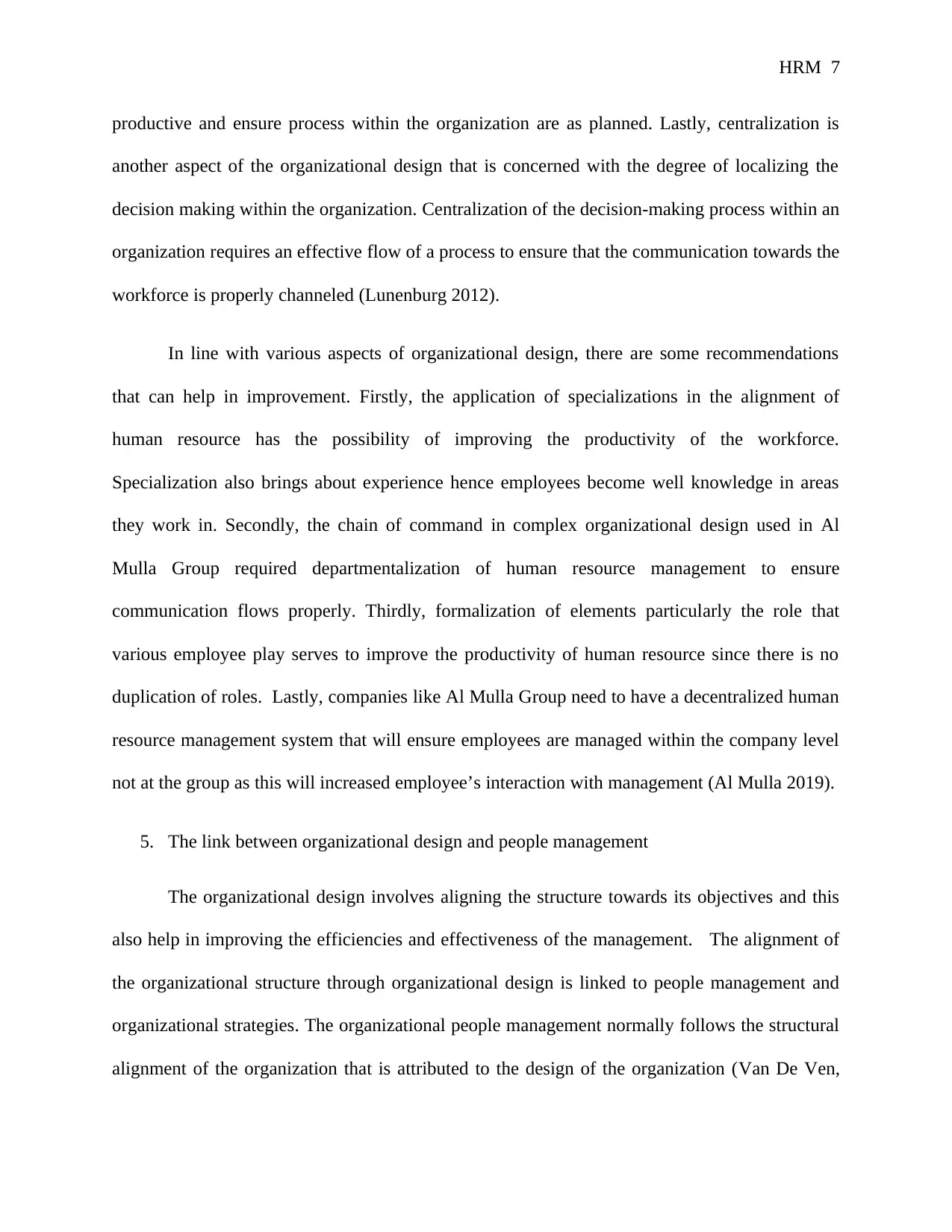
HRM 7
productive and ensure process within the organization are as planned. Lastly, centralization is
another aspect of the organizational design that is concerned with the degree of localizing the
decision making within the organization. Centralization of the decision-making process within an
organization requires an effective flow of a process to ensure that the communication towards the
workforce is properly channeled (Lunenburg 2012).
In line with various aspects of organizational design, there are some recommendations
that can help in improvement. Firstly, the application of specializations in the alignment of
human resource has the possibility of improving the productivity of the workforce.
Specialization also brings about experience hence employees become well knowledge in areas
they work in. Secondly, the chain of command in complex organizational design used in Al
Mulla Group required departmentalization of human resource management to ensure
communication flows properly. Thirdly, formalization of elements particularly the role that
various employee play serves to improve the productivity of human resource since there is no
duplication of roles. Lastly, companies like Al Mulla Group need to have a decentralized human
resource management system that will ensure employees are managed within the company level
not at the group as this will increased employee’s interaction with management (Al Mulla 2019).
5. The link between organizational design and people management
The organizational design involves aligning the structure towards its objectives and this
also help in improving the efficiencies and effectiveness of the management. The alignment of
the organizational structure through organizational design is linked to people management and
organizational strategies. The organizational people management normally follows the structural
alignment of the organization that is attributed to the design of the organization (Van De Ven,
productive and ensure process within the organization are as planned. Lastly, centralization is
another aspect of the organizational design that is concerned with the degree of localizing the
decision making within the organization. Centralization of the decision-making process within an
organization requires an effective flow of a process to ensure that the communication towards the
workforce is properly channeled (Lunenburg 2012).
In line with various aspects of organizational design, there are some recommendations
that can help in improvement. Firstly, the application of specializations in the alignment of
human resource has the possibility of improving the productivity of the workforce.
Specialization also brings about experience hence employees become well knowledge in areas
they work in. Secondly, the chain of command in complex organizational design used in Al
Mulla Group required departmentalization of human resource management to ensure
communication flows properly. Thirdly, formalization of elements particularly the role that
various employee play serves to improve the productivity of human resource since there is no
duplication of roles. Lastly, companies like Al Mulla Group need to have a decentralized human
resource management system that will ensure employees are managed within the company level
not at the group as this will increased employee’s interaction with management (Al Mulla 2019).
5. The link between organizational design and people management
The organizational design involves aligning the structure towards its objectives and this
also help in improving the efficiencies and effectiveness of the management. The alignment of
the organizational structure through organizational design is linked to people management and
organizational strategies. The organizational people management normally follows the structural
alignment of the organization that is attributed to the design of the organization (Van De Ven,
Secure Best Marks with AI Grader
Need help grading? Try our AI Grader for instant feedback on your assignments.
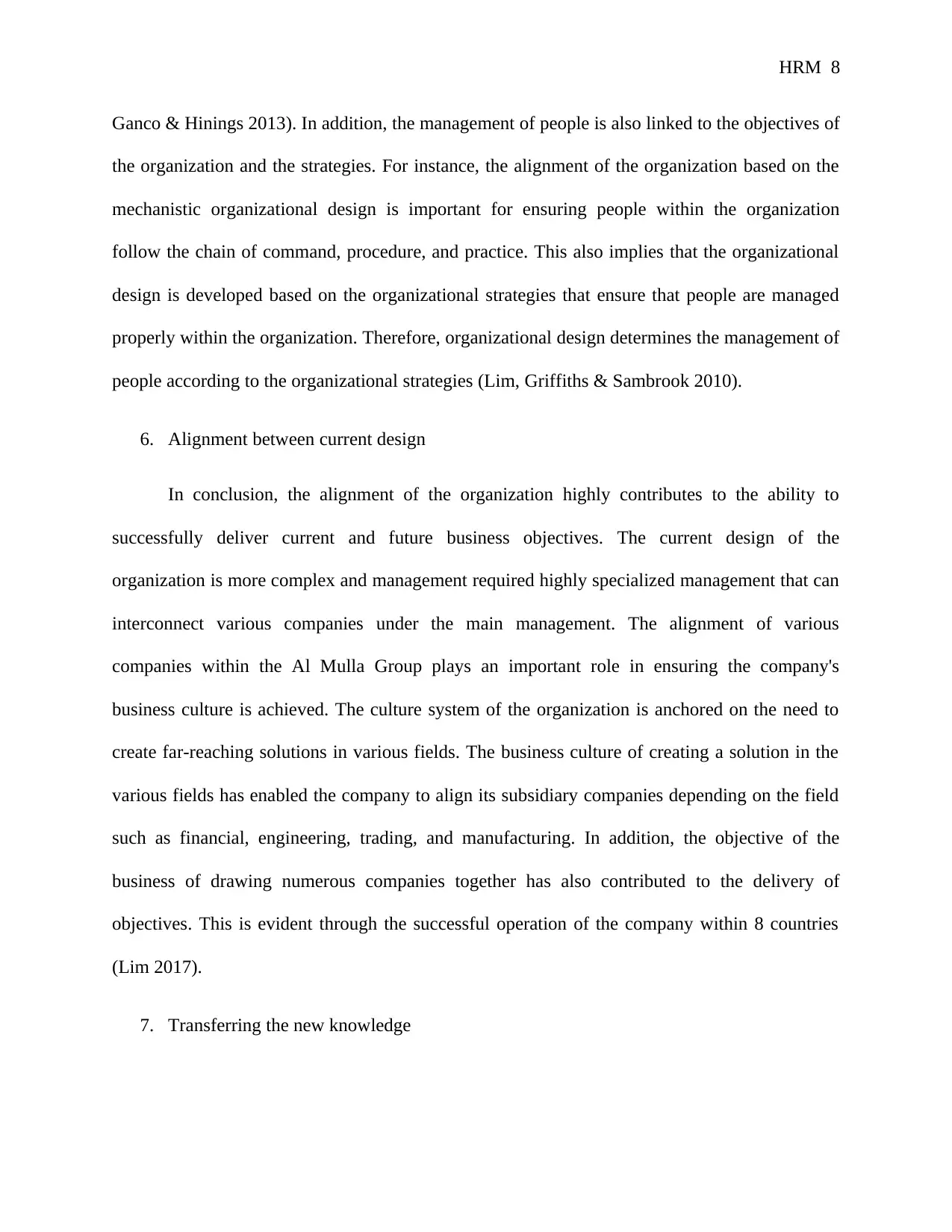
HRM 8
Ganco & Hinings 2013). In addition, the management of people is also linked to the objectives of
the organization and the strategies. For instance, the alignment of the organization based on the
mechanistic organizational design is important for ensuring people within the organization
follow the chain of command, procedure, and practice. This also implies that the organizational
design is developed based on the organizational strategies that ensure that people are managed
properly within the organization. Therefore, organizational design determines the management of
people according to the organizational strategies (Lim, Griffiths & Sambrook 2010).
6. Alignment between current design
In conclusion, the alignment of the organization highly contributes to the ability to
successfully deliver current and future business objectives. The current design of the
organization is more complex and management required highly specialized management that can
interconnect various companies under the main management. The alignment of various
companies within the Al Mulla Group plays an important role in ensuring the company's
business culture is achieved. The culture system of the organization is anchored on the need to
create far-reaching solutions in various fields. The business culture of creating a solution in the
various fields has enabled the company to align its subsidiary companies depending on the field
such as financial, engineering, trading, and manufacturing. In addition, the objective of the
business of drawing numerous companies together has also contributed to the delivery of
objectives. This is evident through the successful operation of the company within 8 countries
(Lim 2017).
7. Transferring the new knowledge
Ganco & Hinings 2013). In addition, the management of people is also linked to the objectives of
the organization and the strategies. For instance, the alignment of the organization based on the
mechanistic organizational design is important for ensuring people within the organization
follow the chain of command, procedure, and practice. This also implies that the organizational
design is developed based on the organizational strategies that ensure that people are managed
properly within the organization. Therefore, organizational design determines the management of
people according to the organizational strategies (Lim, Griffiths & Sambrook 2010).
6. Alignment between current design
In conclusion, the alignment of the organization highly contributes to the ability to
successfully deliver current and future business objectives. The current design of the
organization is more complex and management required highly specialized management that can
interconnect various companies under the main management. The alignment of various
companies within the Al Mulla Group plays an important role in ensuring the company's
business culture is achieved. The culture system of the organization is anchored on the need to
create far-reaching solutions in various fields. The business culture of creating a solution in the
various fields has enabled the company to align its subsidiary companies depending on the field
such as financial, engineering, trading, and manufacturing. In addition, the objective of the
business of drawing numerous companies together has also contributed to the delivery of
objectives. This is evident through the successful operation of the company within 8 countries
(Lim 2017).
7. Transferring the new knowledge

HRM 9
The knowledge learned in organizational design and management of the human resources
in an organization is important for my organizational management. Firstly, organizational
alignment as the main contributor to the structure of the organization will help me understand the
current alignment and future changes that can be affected in the organization for successful
delivery of objectives. Secondly, the link between organizational design and people management
I will use to properly manage human resources in an organization in the future since the
organizational design has increased my understanding of the processes. I have learned the
importance of organizational design and human resources management and I will use this
knowledge in ensuring a good flow of processes. Thirdly, organizational processes and
organizational design is also important for my future designing of workflow and processes in the
organization. I will use the knowledge gained through an understanding of the organizational
design to design workflow in the future. Lastly, the strategic alignment of the structure of an
organization I will apply in holding the right communication channel that ensures the smooth
running of human resources. The strategic alignment of various structures according to the
organizational design model is important for my focus to ensure that the organizational goals are
achieved.
The knowledge learned in organizational design and management of the human resources
in an organization is important for my organizational management. Firstly, organizational
alignment as the main contributor to the structure of the organization will help me understand the
current alignment and future changes that can be affected in the organization for successful
delivery of objectives. Secondly, the link between organizational design and people management
I will use to properly manage human resources in an organization in the future since the
organizational design has increased my understanding of the processes. I have learned the
importance of organizational design and human resources management and I will use this
knowledge in ensuring a good flow of processes. Thirdly, organizational processes and
organizational design is also important for my future designing of workflow and processes in the
organization. I will use the knowledge gained through an understanding of the organizational
design to design workflow in the future. Lastly, the strategic alignment of the structure of an
organization I will apply in holding the right communication channel that ensures the smooth
running of human resources. The strategic alignment of various structures according to the
organizational design model is important for my focus to ensure that the organizational goals are
achieved.
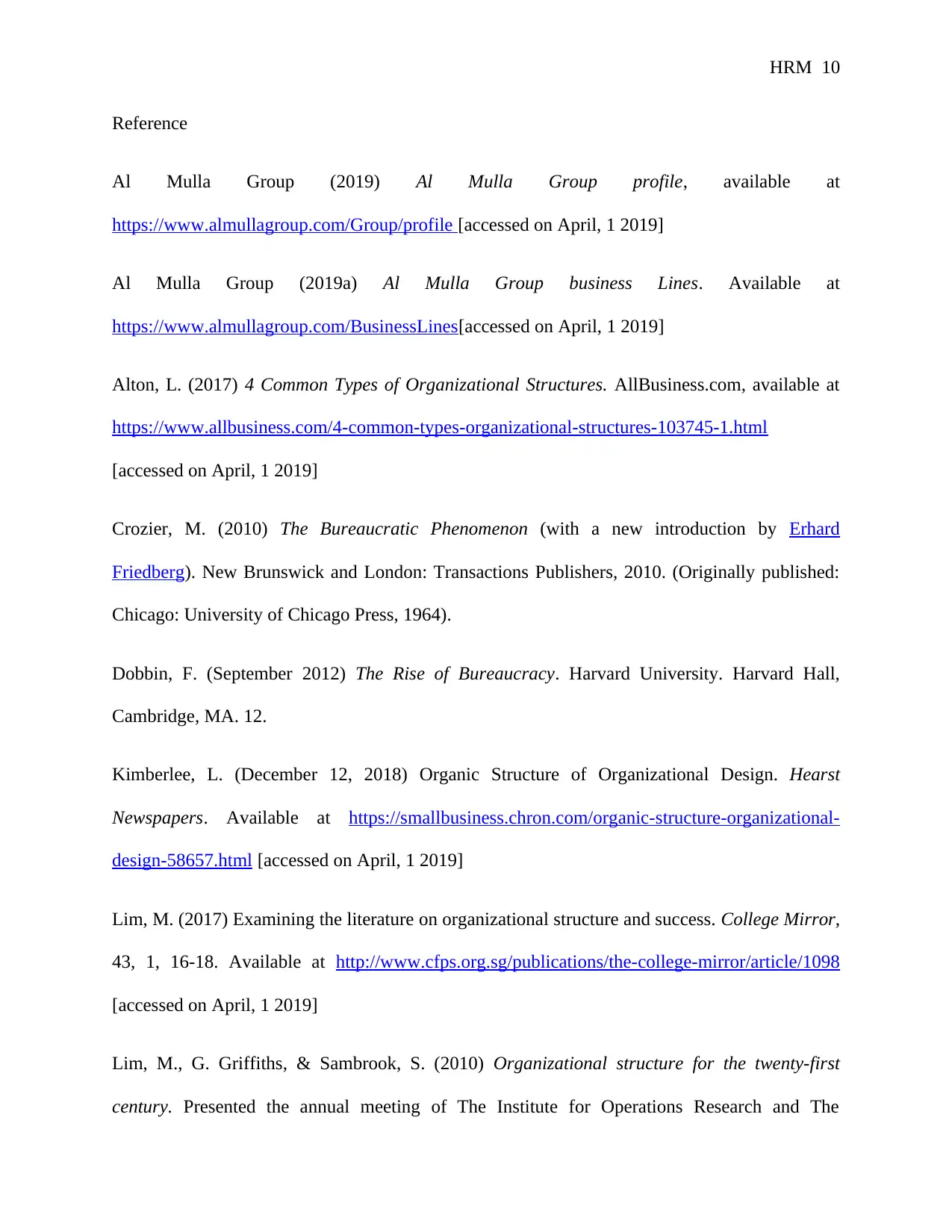
HRM 10
Reference
Al Mulla Group (2019) Al Mulla Group profile, available at
https://www.almullagroup.com/Group/profile [accessed on April, 1 2019]
Al Mulla Group (2019a) Al Mulla Group business Lines. Available at
https://www.almullagroup.com/BusinessLines[accessed on April, 1 2019]
Alton, L. (2017) 4 Common Types of Organizational Structures. AllBusiness.com, available at
https://www.allbusiness.com/4-common-types-organizational-structures-103745-1.html
[accessed on April, 1 2019]
Crozier, M. (2010) The Bureaucratic Phenomenon (with a new introduction by Erhard
Friedberg). New Brunswick and London: Transactions Publishers, 2010. (Originally published:
Chicago: University of Chicago Press, 1964).
Dobbin, F. (September 2012) The Rise of Bureaucracy. Harvard University. Harvard Hall,
Cambridge, MA. 12.
Kimberlee, L. (December 12, 2018) Organic Structure of Organizational Design. Hearst
Newspapers. Available at https://smallbusiness.chron.com/organic-structure-organizational-
design-58657.html [accessed on April, 1 2019]
Lim, M. (2017) Examining the literature on organizational structure and success. College Mirror,
43, 1, 16-18. Available at http://www.cfps.org.sg/publications/the-college-mirror/article/1098
[accessed on April, 1 2019]
Lim, M., G. Griffiths, & Sambrook, S. (2010) Organizational structure for the twenty-first
century. Presented the annual meeting of The Institute for Operations Research and The
Reference
Al Mulla Group (2019) Al Mulla Group profile, available at
https://www.almullagroup.com/Group/profile [accessed on April, 1 2019]
Al Mulla Group (2019a) Al Mulla Group business Lines. Available at
https://www.almullagroup.com/BusinessLines[accessed on April, 1 2019]
Alton, L. (2017) 4 Common Types of Organizational Structures. AllBusiness.com, available at
https://www.allbusiness.com/4-common-types-organizational-structures-103745-1.html
[accessed on April, 1 2019]
Crozier, M. (2010) The Bureaucratic Phenomenon (with a new introduction by Erhard
Friedberg). New Brunswick and London: Transactions Publishers, 2010. (Originally published:
Chicago: University of Chicago Press, 1964).
Dobbin, F. (September 2012) The Rise of Bureaucracy. Harvard University. Harvard Hall,
Cambridge, MA. 12.
Kimberlee, L. (December 12, 2018) Organic Structure of Organizational Design. Hearst
Newspapers. Available at https://smallbusiness.chron.com/organic-structure-organizational-
design-58657.html [accessed on April, 1 2019]
Lim, M. (2017) Examining the literature on organizational structure and success. College Mirror,
43, 1, 16-18. Available at http://www.cfps.org.sg/publications/the-college-mirror/article/1098
[accessed on April, 1 2019]
Lim, M., G. Griffiths, & Sambrook, S. (2010) Organizational structure for the twenty-first
century. Presented the annual meeting of The Institute for Operations Research and The
Paraphrase This Document
Need a fresh take? Get an instant paraphrase of this document with our AI Paraphraser
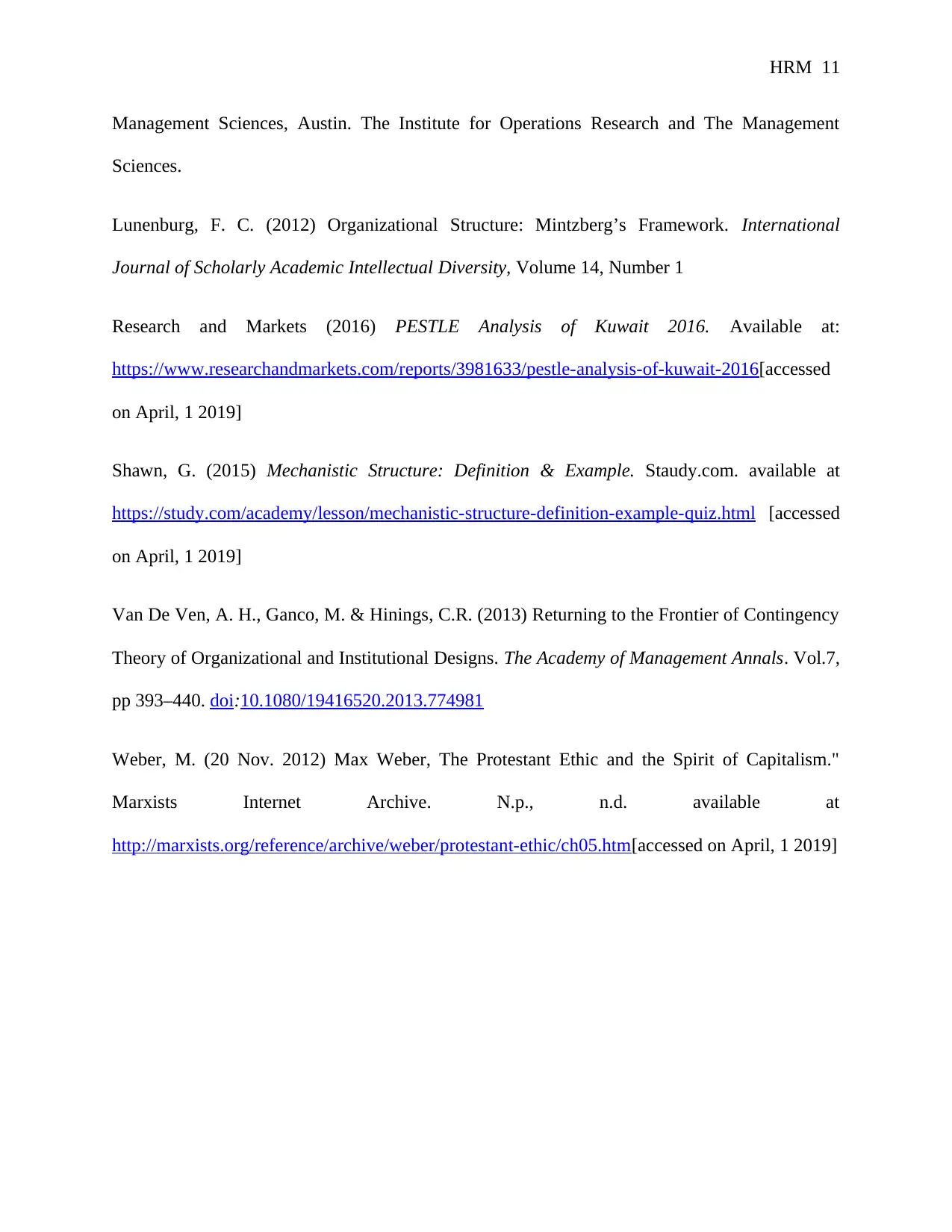
HRM 11
Management Sciences, Austin. The Institute for Operations Research and The Management
Sciences.
Lunenburg, F. C. (2012) Organizational Structure: Mintzberg’s Framework. International
Journal of Scholarly Academic Intellectual Diversity, Volume 14, Number 1
Research and Markets (2016) PESTLE Analysis of Kuwait 2016. Available at:
https://www.researchandmarkets.com/reports/3981633/pestle-analysis-of-kuwait-2016[accessed
on April, 1 2019]
Shawn, G. (2015) Mechanistic Structure: Definition & Example. Staudy.com. available at
https://study.com/academy/lesson/mechanistic-structure-definition-example-quiz.html [accessed
on April, 1 2019]
Van De Ven, A. H., Ganco, M. & Hinings, C.R. (2013) Returning to the Frontier of Contingency
Theory of Organizational and Institutional Designs. The Academy of Management Annals. Vol.7,
pp 393–440. doi:10.1080/19416520.2013.774981
Weber, M. (20 Nov. 2012) Max Weber, The Protestant Ethic and the Spirit of Capitalism."
Marxists Internet Archive. N.p., n.d. available at
http://marxists.org/reference/archive/weber/protestant-ethic/ch05.htm[accessed on April, 1 2019]
Management Sciences, Austin. The Institute for Operations Research and The Management
Sciences.
Lunenburg, F. C. (2012) Organizational Structure: Mintzberg’s Framework. International
Journal of Scholarly Academic Intellectual Diversity, Volume 14, Number 1
Research and Markets (2016) PESTLE Analysis of Kuwait 2016. Available at:
https://www.researchandmarkets.com/reports/3981633/pestle-analysis-of-kuwait-2016[accessed
on April, 1 2019]
Shawn, G. (2015) Mechanistic Structure: Definition & Example. Staudy.com. available at
https://study.com/academy/lesson/mechanistic-structure-definition-example-quiz.html [accessed
on April, 1 2019]
Van De Ven, A. H., Ganco, M. & Hinings, C.R. (2013) Returning to the Frontier of Contingency
Theory of Organizational and Institutional Designs. The Academy of Management Annals. Vol.7,
pp 393–440. doi:10.1080/19416520.2013.774981
Weber, M. (20 Nov. 2012) Max Weber, The Protestant Ethic and the Spirit of Capitalism."
Marxists Internet Archive. N.p., n.d. available at
http://marxists.org/reference/archive/weber/protestant-ethic/ch05.htm[accessed on April, 1 2019]
1 out of 11
Related Documents
Your All-in-One AI-Powered Toolkit for Academic Success.
+13062052269
info@desklib.com
Available 24*7 on WhatsApp / Email
![[object Object]](/_next/static/media/star-bottom.7253800d.svg)
Unlock your academic potential
© 2024 | Zucol Services PVT LTD | All rights reserved.





